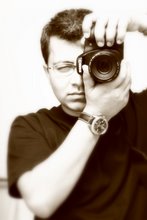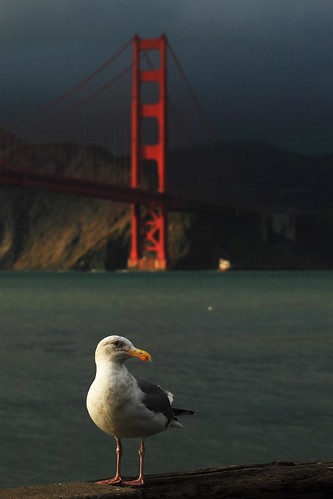
Wednesday, December 30, 2009
What "not to worry" about
Movies Worth Watching-Trust me you won't regret
Tuesday, December 29, 2009
Thought Behind the Shot-2
- How do you predict the time lightning will strike to click the shutter at the same time?
- How do you select the exposure as everything is dark till lightning strikes?
- Pointed the camera at approximately the direction in which maximum lightning was occurring
- Selected Manual Exposure and chose a long exposure of about 20 seconds and f4 (I could have chosen slightly higher aperture at say f5.6)
- Selected Manual Focus and set it to infinity
- Clicked and prayed there would be a lightning strike in those 20 seconds
Thought Behind the Shot-1
- Selected aperture priority (needed the perfect depth of field to blur the bridge)
- Luckily already had my 70-200 lens on
- Selected a focusing point at the bottom third of the frame and shot...
10 Tips for first time SLR buyers
- Mega Pixels: MP does not matter anymore, at least not for people who print postcard size or even A4 size (tell me honestly how many digital pictures have you printed and framed on your wall). Anything above 6 is good and all SLRs today are well above that. If you are turning pro you might worry about it but then you wouldn't be reading this
- Canon or Nikon: Don't worry both are excellent. Once you start using them you get used and intuitively move your fingers while still looking through the viewfinder. Both offer a plethora of lenses and independent manufacturers like Sigma, Tamron, Tokina and even Zeiss makes lenses with Canon or Nikon mounts
- Zoom: This was the "in thing" in the 90s. First of all no SLR comes with in built zoom, only point and shoots do. Select your zoom according to your need. For example if you shoot a lot of landscape select 10-22, 12-24 or 18-55 and if you shoot wildlife select among 70-300, 200-400. For zoom lovers Sigma makes a 50-500 lens. And now the dampener-Prime (fixed focal length lenses) lenses are almost always better than zoom lenses but again if you are reading this you do not need to know why and trust me you won't know the difference
- The zoom lens that comes with the camera: If you can buy body only, buy it. The lens with the camera is almost always a dud, especially with amateur SLRs. You would be better off buying the body only with the 50mm f1.8 (Rs 4000) and then save money to buy a wide angle and a telephoto zoom. And i know none of you will listen to me on this one
- Live View: Ok you got used to it in your point and shoot and want it in your SLR. Even if the SLR has the option please shut it. My personal experience is that good composition comes with looking at the composition through the viewfinder and not at a screen which is a fraction of what your eye can see, along with all other disturbances. Moreover the LCD screen eats a lot of battery. If you are intending to become a pro, tell me how many pros have you seen using a Live View?
- Can I buy Used: Yes, yes, yes. Remember these cameras do not have great 2nd hand value and the manufacturers keep upgrading every 2 years or so and a lot of people fall for those extra 5 megapixels and some sale gimmick feature which will never be used so there will be a lot of cameras available. Lenses are a safe bet as the only things you need to worry about is fungus, which is visible when you inspect it and auto focus which you can test with a camera at the store itself
- Where to buy: If you are in the US: www.bhphotovideo.com, www.amazon.com, www.adorama.com. these guys almost always offer the least prices and if they ship it, there is NO tax and they are extremely trustworthy, even for used. In India www.jjmehta.com offers a good range of cameras and lenses
- Third Party Lenses: Yes you can buy the Sigma, Tamron, Tokina lenses for much lesser prices than Canon or Nikon but Caveat Emptor. I have a Sigma 105mm f2.8 Macro 1:1 which beats all my Canon Lenses on sharpness but the auto focus stopped working. Similarly my Tamron 200-400 auto focus also stopped working but Tamron repaired it for free even though it was out of warranty and they even cleaned a spot of fungus inside. That's customer delight
- Accessories: First get a good bag, a big bag, a sturdy bag as you will add to your kitty and you do not want to expose all this to dust and if something falls you don't have to weep. I have dropped my Pelican case with all my equipment at airports from the push cart and still nothing is broken. Get polarizers for your lenses. You don't have to buy one for every lens. Just buy one or two matching the circumference of your lenses. Buy bigger sizes and you can buy adapters to fit it into smaller size lenses. Google about how to use a polarizer and what it does, you will see a marked difference when you use it. Get a tripod, you won't regret it.
- Do I need an SLR: If you are asking yourself this then you obviously do not because you do not know what it can do so first read about it, google and gain knowledge and then you will not ask
Sharpness
Sharpness:
Myth: To get sharpness in your landscape images keep aperture at f/8 minimum. Myth Buster: Some experts even recommend very very small apertures, to the effect of f/22. Actually what happens is that Depth of Field increases at smaller apertures and thus gives a feel of better sharpness. To get better DOF at wider apertures read about "Hyperfocal Distance" below
Myth Buster: Some experts even recommend very very small apertures, to the effect of f/22. Actually what happens is that Depth of Field increases at smaller apertures and thus gives a feel of better sharpness. To get better DOF at wider apertures read about "Hyperfocal Distance" below
But there are some issues with doing the above. Firstly, If you have sensor dust, it will show when you go beyond f/8 or f/11. Whats the solution? Keep touching up the photos post clicking or get your sensor dust cleaned.
Secondly, at very small apertures diffraction occurs, which means rather than sharpness increasing, the picture actually gets softer. To know more about this read http://www.kenrockwell.com/tech/diffraction.htm
The aperture I love personally is f/8. This works for most lenses. My Sigma 105mm f/2.8, 1:1 Macro rocks at this aperture. Depending on the widest aperture a lens has, the sweet spot of a lens is around the f/5.6 to f/8 mark in general.
To Improve DOF focus on the Hyperfocal Distance-http://www.dofmaster.com/hyperfocal.html, instead of focusing at the nearest object or at infinity
How to get sharper images?
1) Use a Tripod as often as possible. This avoids any camera shake due to lower shutter speeds. SLR cameras have a "mirror lock up" function which avoids shake due to jarring of the mirror. Use a remote to click instead of the click button on the camera to further avoid shake. Rule of thumb for hand held shots-do not decrease shutter speed below the reciprocal of the focal length. For example do not reduce shutter speed below 1/200 for a 200 mm lens. At least use a monopod or support, it really helps
2) If you have the budget you could also buy lenses with Image Stabilizers (Canon) or Vibration Reduction (Nikon) or any other lens which has this functionality to avoid shake, they are worth it. Instead of forcing customers to upgrade lenses with Is these companies could come up with cameras with IS but then how would they make money?
3) Manual Focus: Sounds counter intuitive? Its true, most of the time manual focus will give you better results than auto focus, especially if you are working out of a tripod. I accidentally discovered this when the auto focus feature of my Sigma 105mm f/2.8, 1:1 Macro stopped working. I was forced to focus manually and suddenly discovered what my lens was capable of at f/8, be it portraits or Macro. most of my portraits are with this lens. If you are a beginner, I would suggest that you take your photos both in auto and in manual mode where ever possible till the time you master the art of manual focus. Cameras autofocus can get fooled and some lenses (for SLRs) have some calibration issues with the camera body
Try the above and you will find the sharpness of your images a notch above the results you have been getting. Good Luck!
Does equipment matter?
- A lens which could focus on the object I wanted in focus and render everything else out of focus
- Which also meant the lens should have aperture settings
- You cannot shoot life size (1:1) or closer without a macro lens (or at least an adapter to reverse fit a normal lens)
- You need a tripod and a sturdy one at that to get light streaks of cars passing by a busy street or water flowing
- You need a 300mm + lens to shoot a close up of the King of the Jungle or a tiger or cheetah unless you are like the heroes on National Geographic/Discovery who are used to handling Black Mambas with bare hands
- Despite all tall claims with regard to auto focus, manual focus almost always renders sharper pictures and for that you need lenses which allow you manual override, focusing screens which aid in perfect focusing or angle finders which enable enlargement of the viewfinder and aid in perfect focusing
- You need filters or at least photoshop, to get deep colors and contrast in images
- Do not worry and waste time reading reviews of 20 different cameras and 50 different lenses. Buy according to what you can afford and you will be fine. Studio experiments between lenses are good only for studios or unless you are a professional making money out of selling photographs which are blown poster size
- Buy a basic SLR (DO NOT worry about megapixels, anything above 6 is more than you need)
- Spend more money on lenses but choose wisely. You for sure DO NOT need a 50mm f1.2 (around Rs 70000) or 85mm 1.2 lens (above Rs 1 lakh), the 50 mm 1.8 and 85mm 1.8 will do fine (both cost approximately between Rs 15-20k)
- Here is what you need in lenses:
- For Landscapes: Ultra wide 10-22 or 12-24, 18-90 will also do
- For Portraits: Any lens with focal length of 50mm up to 135 mm or above
- For Wildlife: 200-400
- For Macros: Any Macro lens with 1:1 magnification ratio
- A polarizing filter (or a couple) for lenses
- A good kit bag (you do not want to accidentally spill anything from the above)



